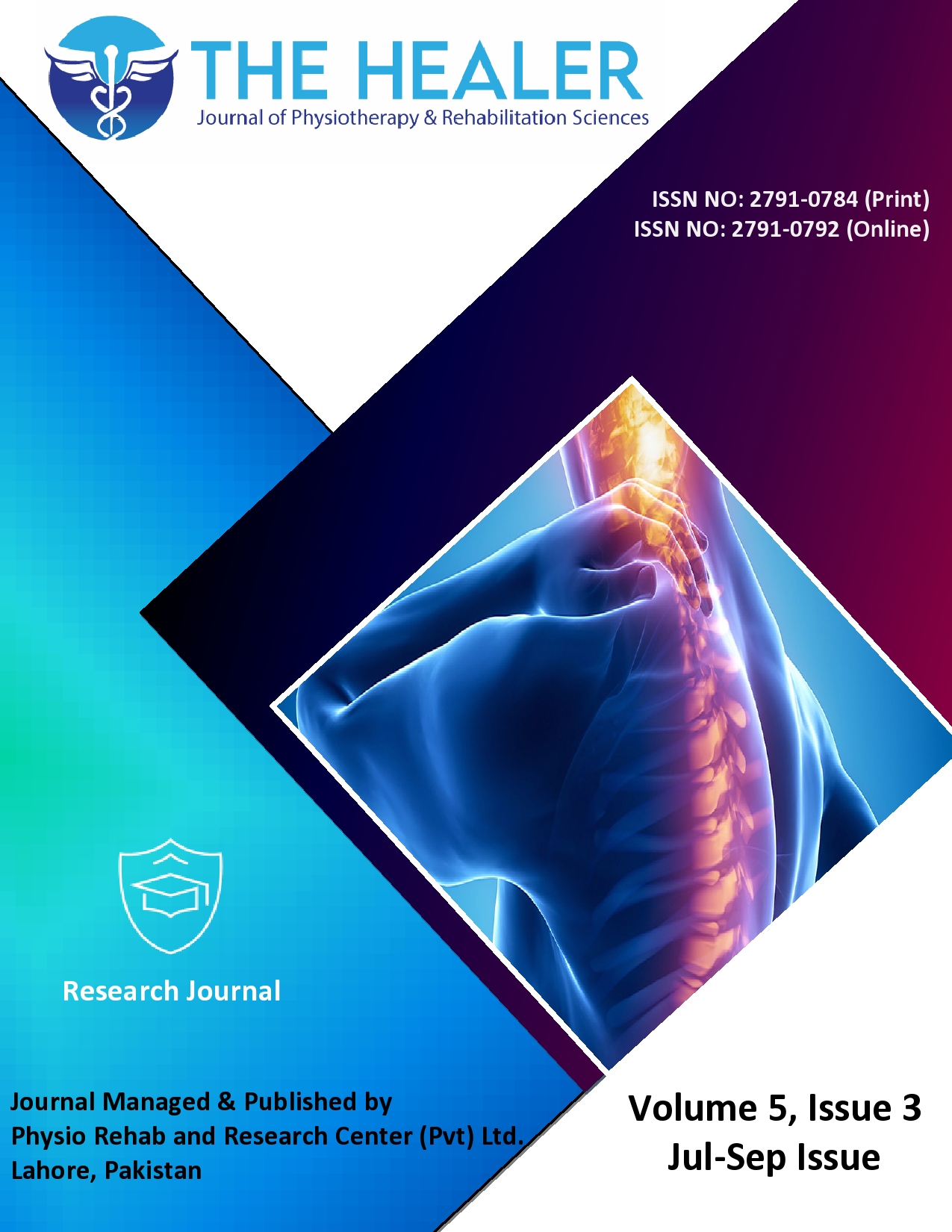Rehabilitation Strategies for Anterior Shoulder Instability in Patients with Post-Arthroscopic Bankart Repair
DOI:
https://doi.org/10.55735/2j79xc57Keywords:
Anterior shoulder instability , Arthroscopic Bankart repair , Rehabilitation , Shoulder stability , Surgical interventionAbstract
Anterior shoulder instability is a common condition, particularly among young and active individuals, often resulting from repetitive stress or traumatic events. Surgical intervention, most notably arthroscopic Bankart repair, is frequently required to restore shoulder stability and prevent recurrence. Despite advancements in surgical techniques, the foundation of successful recovery lies in a structured, individualized rehabilitation program. Rehabilitation progresses through defined phases, beginning with immobilization and pain control, then advancing to mobilization, strengthening, and proprioceptive training. Each stage is aimed at protecting healing tissues, restoring neuromuscular control, and ensuring a safe return to activity. A major challenge in managing anterior shoulder instability is the lack of consensus on optimal postoperative protocols and surgical indications. Variability in patient demographics, anatomical differences, and surgeon preferences contributes to inconsistencies in treatment strategies. In cases involving significant bone loss or engaging Hill-Sachs lesions, additional procedures such as remplissage or the Latarjet technique may be necessary to enhance stability and outcomes. Personalized care remains essential. Factors such as patient age, activity level, and anatomical considerations must guide treatment decisions. The development of standardized guidelines, improved imaging for surgical planning, and long-term studies evaluating joint health and functional outcomes are needed. A multidisciplinary approach, combining the expertise of surgeons, physiotherapists, and patients in a shared decision-making process, is crucial for optimizing recovery and patient satisfaction. A comprehensive, tailored strategy that integrates precise surgical intervention with evidence-based rehabilitation offers the most effective path to durable recovery and functional restoration in individuals with anterior shoulder instability. Importantly, the management approach must be thoughtfully individualized, taking into account patient age, activity level, and the specific nature of the injury. By integrating patient goals with evolving evidence, clinicians can continue to improve both the quality and durability of treatment, helping patients regain confidence.
Downloads
References
1. Ma R, Brimmo OA, Li X, Colbert L. Current Concepts in Rehabilitation for Traumatic Anterior Shoulder Instability. Current Reviews in Musculoskeletal Medicine. 2017; 10(4): 499-506.
https://doi.org/10.1007/s12178-017-9449-9
2. Jaggi A, Alexander S Rehabilitation for Shoulder Instability - Current Approaches. The Open Orthopaedics Journal. 2017; 11: 957-971.
https://doi.org/10.2174/1874325001711010957
3. Bateman M, Smith BE, Osborne SE, Wilkes SR. Physiotherapy treatment for atraumatic recurrent shoulder instability: early results of a specific exercise protocol using pathology-specific outcome measures. Shoulder & Elbow. 2015; 7(4): 282-288.
https://doi.org/10.1177/1758573215592266
4. Clifford AL, Hurley E, Doyle TR, et al. Treatment of Anterior Shoulder Instability: A Comprehensive Review. Journal of Hand Surgery Global Online. 2024: 6(5): 610-613.
https://doi.org/10.1016/j.jhsg.2024.04.013
5. Dumont GD, Russell RD, Robertson WJ. Anterior shoulder instability: a review of pathoanatomy, diagnosis and treatment. Current Reviews in Musculoskeletal Medicine. 2011: 4(4): 200-207.
https://doi.org/10.1007/s12178-011-9092-9
6. Hurley ET, Manjunath AK, Bloom DA, et al. Arthroscopic Bankart repair versus conservative management for first-time traumatic anterior shoulder instability: a systematic review and meta-analysis. Arthroscopy. 2020; 36(9): 2526-2532.
https://doi.org/10.1016/j.arthro.2020.04.046
7. Bartl C, Imhoff AB. Arthroscopic Capsulolabral Revision Repair for Recurrent Anterior Shoulder Instability. JBJS Essential Surgical Techniques. 2012; 2(1): e2.
https://doi.org/10.2106/JBJS.ST.K.00023
8. Utami SW, Pratiwi SR, Mitchel M, Gani KS, Jeon I. Return to sports following arthroscopic Bankart repair: a narrative review. EWHA Medical Journal. 2024; 47(2):e1.
https://doi.org/10.12771/emj.2024.e21
9. Sonone SV, Sasun A, Lanke P, Phansopkar P. Outcome analysis of accelerated physiotherapy rehabilitation following arthroscopic repair of bankart lesion and soft tissue reconstruction: A case report. Medical Science. 2022; 26(124): 1-8.
https://doi.org/10.54905/disssi/v26i124/ms250e2252
10. Varacallo MA, Musto MA, Mair SD. Anterior Shoulder Instability. Treasure Island (FL): StatPearls Publishing; 2025. https://www.ncbi.nlm.nih.gov/books/NBK538234/
11. Glazebrook H, Miller B, Wong I. Anterior Shoulder Instability: A Systematic Review of the Quality and Quantity of the Current Literature for Surgical Treatment. Orthopaedic Journal of Sports Medicine. 2018; 6(11).
https://doi.org/10.1177/2325967118805983
12. Voos JE, Livermore RW, Feeley BT, et al. - Prospective evaluation of arthroscopic Bankart repairs for anterior instability. American Journal of Sports Medicine. 2010; 38(2): 302-7.
https://doi.org/10.1177/0363546509348049
13. Owens BD, Harrast JJ, Hurwitz SR, et al. Surgical trends in Bankart repair:an analysis of data from the American Board of Orthopaedic Surgery certification examination. American Journal of Sports Medicine. 2011; 39(9): 1865-9.
https://doi.org/10.1177/0363546511406869
14. Pak T, Kim AM. Anterior Glenohumeral Joint Dislocation. Treasure Island (FL): StatPearls Publishing; 2025. https://www.ncbi.nlm.nih.gov/books/NBK557862/
15. Liaghat B, Pedersen JR, Husted RS, et al. Diagnosis, prevention and treatment of common shoulder injuries in sport: grading the evidence - a statement paper commissioned by the Danish Society of Sports Physical Therapy (DSSF). British Journal of Sports Medicine. 2023; 57(7): 408-416.
https://doi.org/10.1136/bjsports-2022-105674
16. Gaballah A, Zeyada M, Elgeidi A, Bressel E. Six-week physical rehabilitation protocol for anterior shoulder dislocation in athletes. Journal of Exercise Rehabilitation. 2017; 13(3): 353-358.
https://doi.org/10.12965/jer.1734976.488
17. Apostolakos JM, Wright-Chisem J, Gulotta, LV, et al. Anterior glenohumeral instability: Current review with technical pearls and pitfalls of arthroscopic soft-tissue stabilization. World Journal of Orthopedics. 2021; 12(1): 1-13.
https://doi.org/10.5312/wjo.v12.i1.1
18. Mirzayan R, Itoi E, Karpyshyn J, et al. Controversies in the surgical management of anterior shoulder instability. State of the Art. Journal of ISAKOS. 2024; 9(2): 168-183.
https://doi.org/10.1016/j.jisako.2023.10.008
19. Zhang M, Yang Z, Zhang B, et al. Treatment of anterior shoulder instability: Journal of Orthopaedic Surgery and Research. 2022; 17: 23.
https://doi.org/10.1186/s13018-022-02913-z
20. Brownson P, Donaldson O, Fox M, Rees JL, Rangan A, Jaggi A, et al. BESS/BOA Patient Care Pathways: Traumatic anterior shoulder instability. Shoulder & Elbow. 2015; 7(3): 214-226.
https://doi.org/10.1177/1758573215585656
21. Friedman LGM, Lafosse L, Garrigues GE. Global Perspectives on Management of Shoulder Instability: Decision Making and Treatment. The Orthopedic Clinics of North America. 2020; 51(2): 241-258.
https://doi.org/10.1016/j.ocl.2019.11.008
22. Adam M, Attia AK, Alhammoud A, et al. Arthroscopic Bankart repair for the acute anterior shoulder dislocation: systematic review and meta-analysis. International Orthopaedics. 2018: 42(10): 2413-2422.
https://doi.org/10.1007/s00264-018-4046-0
23. Novakofski KD, Melugin HP, Leland DP, et al. Nonoperative management of anterior shoulder instability can result in high rates of recurrent instability and pain at long-term follow-up. Journal of Shoulder and Elbow Surgery. 2002; 31(2): 352-358.
https://doi.org/10.1016/j.jse.2021.07.016
24. Yates JB, Choudhry MN, Waseem M. Managing Bony Defects of the Shoulder Joint that Occur in Association with Dislocation. The Open Orthopaedics Journal. 2017; 11: 1245-1257. https://doi.org/10.2174/1874325001711011245
25. Sofu H, Gürsu S, Koçkara N, et al. Recurrent anterior shoulder instability: Review of the literature and current concepts. World Journal of Clinical Cases. 2014; 2(11): 676-682. https://doi.org/10.12998/wjcc.v2.i11.676
26. Avila Lafuente JL, Moros Marco S, García Pequerul JM. Controversies in the Management of the First-Time Shoulder Dislocation. The Open Orthopaedics Journal. 2017; 11: 1001-1010. https://doi.org/10.2174/1874325001711011001
27. Dala-Ali B, Penna M, McConnell J, et al. Management of acute anterior shoulder dislocation. British Journal of Sports Medicine. 2014; 48(16): 1209-1215.
https://doi.org/10.1136/bjsports-2012-091300
28. Kuhn JE. Treating the initial anterior shoulder dislocation with an evidence-based medicine approach. Sports Medicine and Arthroscopy Review. 2006; 14(4): 192-198.
https://doi.org/10.1097/01.jsa.0000212328.25345.de
29. Bauer S, Collin P, Zumstein MA, et al. Current concepts in chronic traumatic anterior shoulder instability. EFORT Open Reviews. 2023; 8(6): 468-481.
https://doi.org/10.1530/EOR-22-0084
30. Balke, M., Shafizadeh, S., Bouillon, B. et al. Management of shoulder instability: the current state of treatment among German orthopaedic surgeons. Archives of Orthopaedic and Trauma Surgery. 2016; 136: 1717-1721.
https://doi.org/10.1007/s00402-016-2553-2
31. Aboalata M, Plath JE, Seppel G, et al. Results of arthroscopic Bankart repair for anterior-inferior shoulder instability at 13-year follow-up. American Journal of Sports Medicine. 2016; 45(4): 782-787.
https://doi.org/10.1177/0363546516675145
32. White AE, Patel NK, Hadley CJ, Dodson CC. An Algorithmic Approach to the Management of Shoulder Instability. Journal of the American Academy of Orthopaedic Surgeons. Global Research & Reviews. 2019; 3(12): e19.00168.

Downloads
Published
License
Copyright (c) 2025 The Healer Journal of Physiotherapy and Rehabilitation Sciences

This work is licensed under a Creative Commons Attribution 4.0 International License.














